Understanding the 100k Ohm Resistor: Uses, Color Code & More
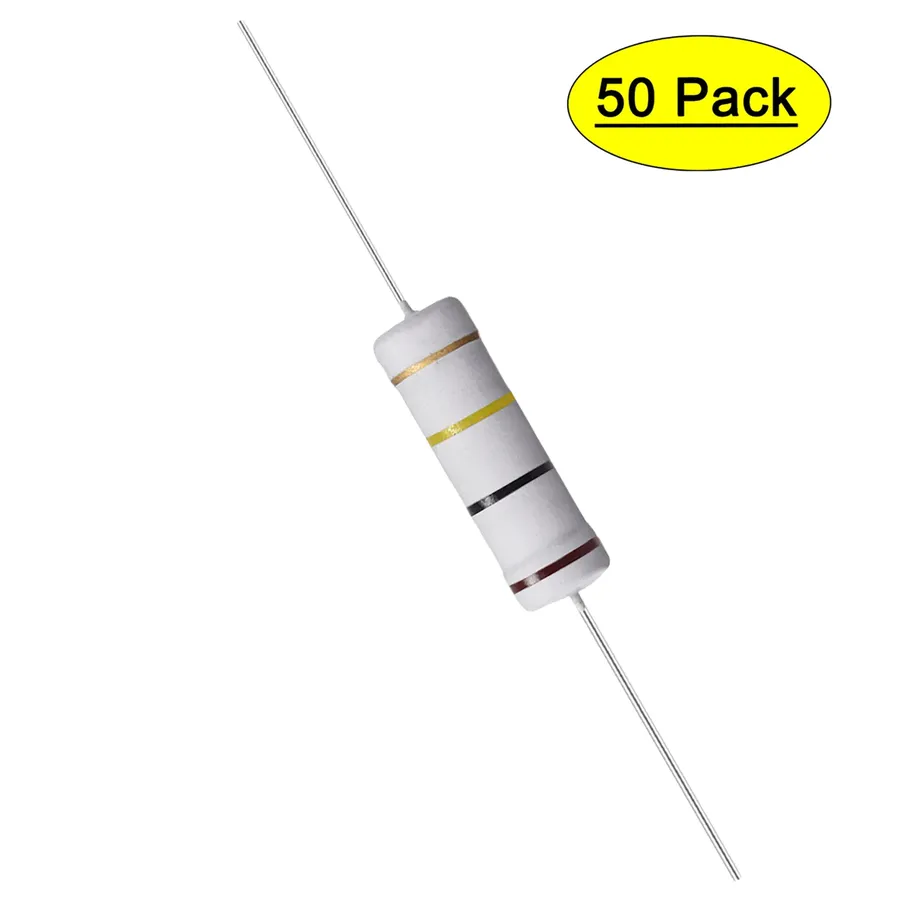
The 100k ohm resistor, a seemingly tiny component, plays a monumental role in the world of electronics, much like how a single neuron contributes to the vast complexity of the brain. From controlling current flow to setting voltage levels, it's the unsung hero in circuits everywhere. This article dives deep into understanding the 100k ohm resistor, from its basic properties to its various applications, and will help you understand why it is a staple in electronics projects. We'll explore its color code, where to find it and how it is an essential part of any electronics hobbyist's toolkit.
What is a 100k Ohm Resistor?

A 100k ohm resistor is a passive electronic component designed to impede the flow of electrical current, presenting a resistance of 100,000 ohms. This specific value is frequently used in electronic circuits to control current, create voltage drops, and enable various functions. The fundamental principle of resistance, measured in ohms (Ω), dictates the opposition a material offers to the movement of electrons.
Decoding the 100k Ohm Resistor Color Code
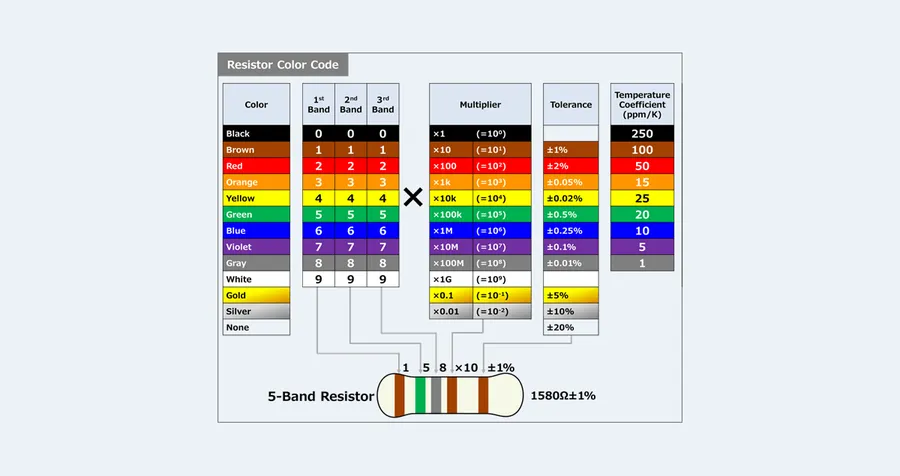
Identifying a 100k ohm resistor relies on understanding its color-coded bands, a standardized system that indicates the resistor's value, tolerance, and sometimes its temperature coefficient. This section details how to interpret these bands for both 4-band, 5-band, and 6-band resistor configurations, providing a practical guide for electronic circuit analysis and construction.
| Color | Digit | Multiplier | Tolerance |
|---|---|---|---|
| Black | 0 | 1 | – |
| Brown | 1 | 10 | 1% |
| Red | 2 | 100 | 2% |
| Orange | 3 | 1,000 | – |
| Yellow | 4 | 10,000 | – |
| Green | 5 | 100,000 | 0.5% |
| Blue | 6 | 1,000,000 | 0.25% |
| Violet | 7 | 10,000,000 | 0.1% |
| Gray | 8 | – | 0.05% |
| White | 9 | – | – |
| Gold | – | 0.1 | 5% |
| Silver | – | 0.01 | 10% |
For a 100k ohm resistor, the color bands will vary depending on the number of bands. A 4-band resistor will utilize two significant digit bands, one multiplier band, and one tolerance band. A 5-band resistor will have three significant digits, one multiplier, and a tolerance band. The 6-band configuration is the same as 5-band but also includes an additional temperature coefficient band. Below, each is explained in detail with the example of a 100k ohm resistor.
**4-Band Resistor:** The 4-band resistor is the most common configuration. It consists of two significant figure bands, followed by a multiplier band, and then the tolerance band. For a 100k ohm resistor, the color sequence would be: 1. **Brown** (1st digit - 1) 2. **Black** (2nd digit - 0) 3. **Yellow** (Multiplier - 10,000) 4. **Gold or Silver** (Tolerance - 5% or 10%)
**5-Band Resistor:** The 5-band resistor is more precise and has 3 significant figure bands, followed by a multiplier band, and then the tolerance band. For a 100k ohm resistor, the color sequence would be: 1. **Brown** (1st digit - 1) 2. **Black** (2nd digit - 0) 3. **Black** (3rd digit - 0) 4. **Orange** (Multiplier - 1,000) 5. **Brown, Red, Green, Blue, Violet or Grey** (Tolerance - 1%, 2%, 0.5%, 0.25%, 0.1%, or 0.05% respectively).
**6-Band Resistor:** The 6-band resistor is the same as the 5-band with the addition of a temperature coefficient band after the tolerance band. The first five bands are identical to the 5-band resistor, then the sixth band is the Temperature Coefficient band which is usually **Brown** (100 ppm/°C) or **Red** (50 ppm/°C).
When reading a resistor, it's crucial to identify the correct starting point. Generally, the tolerance band (gold or silver) is placed on the right, and the reading starts from the left. It is also worth noting that some resistors have a wider spacing between the tolerance band and the rest of the bands to help identify the reading direction.
100k Ohm Resistor Applications
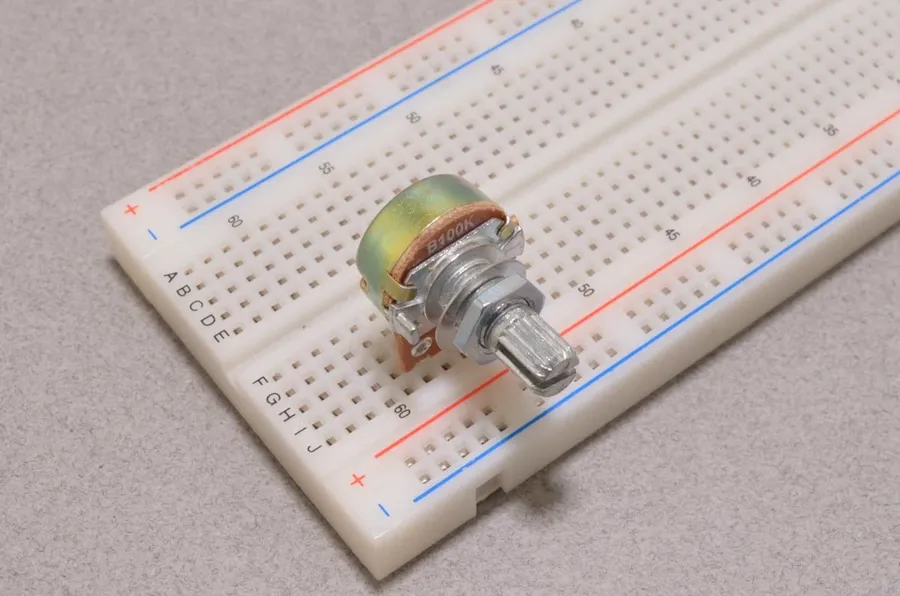
The 100k ohm resistor is a versatile passive component employed across numerous electronic applications due to its ability to limit current flow and establish specific voltage levels within a circuit. Its common applications range from simple current regulation to crucial roles in complex digital interfaces and sensing technologies.
In the realm of everyday circuits, the 100k ohm resistor is frequently used for:
- LED Current Limiting
When used in series with an LED, a 100k ohm resistor can limit the current flowing through the LED, preventing it from burning out, thereby ensuring a safe and sustained light output. This is crucial because LEDs are current-sensitive devices. - Voltage Dividers
Two or more resistors, including a 100k ohm resistor can be arranged to create a voltage divider circuit, which provides a fraction of the applied voltage. This is essential in creating reference voltages for sensors or setting the operating voltage of other components. - Pull-up and Pull-down Resistors
In digital circuits, 100k ohm resistors are frequently used as pull-up or pull-down resistors. A pull-up resistor keeps a digital input high (typically 5V or 3.3V) when no signal is present, while a pull-down resistor keeps the input low (0V). These ensure that the input is always at a defined level, avoiding undefined or floating states and is very crucial in the reliable operation of digital circuits. - Sensing Circuits
In various sensor applications, 100k ohm resistors are used to form part of a sensing circuit. These are especially useful when working with sensors that can affect resistance as they measure physical quantities like light, pressure or temperature. By carefully selecting resistor values, the sensor circuit can provide measurable output when exposed to different environments
Real-world applications of 100k ohm resistors include their usage in:
- Amplifier Feedback Circuits
In operational amplifier (op-amp) circuits, 100k ohm resistors are often used in feedback networks to control gain, stability and frequency response of the amplifier. These resistors provide a feedback path that influences the amplifier's behavior and performance characteristics. - Analog-to-Digital Converters (ADCs)
In ADC circuits, the 100k ohm resistor plays a critical role in setting the input signal range and the required level for proper conversion of analog signals into digital data. These resistors aid in the signal conditioning and voltage scaling before entering the ADC. - Timing Circuits
In timing circuits, especially RC (resistor-capacitor) circuits, 100k ohm resistors work with capacitors to establish precise timing delays, which are extensively used in generating clock pulses or triggering events in microcontroller based projects and automated system.
Power Rating and Tolerance of 100k Ohm Resistors
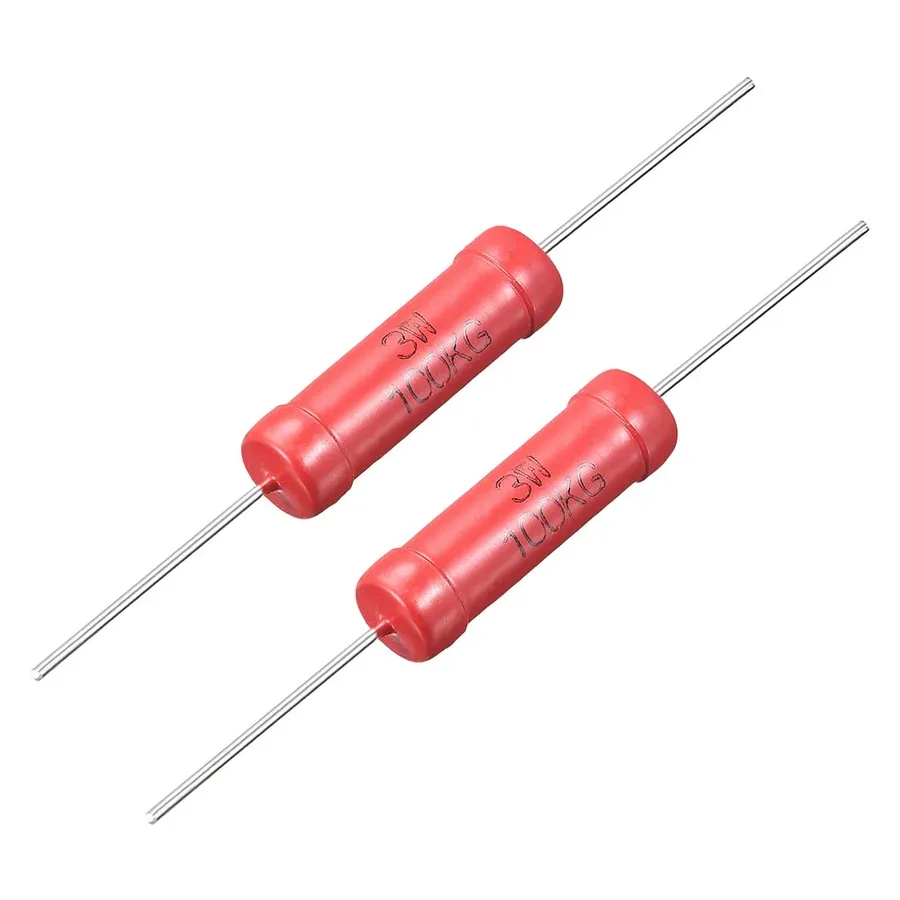
The power rating and tolerance of a 100k ohm resistor are crucial specifications that dictate its performance and suitability for a particular application. These parameters determine how much power the resistor can safely dissipate and the accuracy of its resistance value, respectively.
Power rating, typically expressed in watts (W), specifies the maximum amount of power a resistor can handle without overheating and potentially failing. For 100k ohm resistors, common power ratings are 1/4W (0.25W) and 1/2W (0.5W). Exceeding this rating can lead to resistor damage, drift in resistance, or even complete failure.
Tolerance, usually given as a percentage (%), defines the acceptable deviation of the resistor's actual value from its nominal value (100k ohms in this case). A typical tolerance for standard 100k ohm resistors is 5%, which means the actual resistance can range from 95k ohms to 105k ohms. Higher precision resistors with tolerances of 1% or less are also available for applications that require more accurate resistance.
| Parameter | Description | Typical Values for 100k Ohm Resistors |
|---|---|---|
| Power Rating | Maximum power a resistor can dissipate safely | 1/4W (0.25W), 1/2W (0.5W) |
| Tolerance | Acceptable deviation of the actual resistance from the nominal value | 5%, 1% (or lower for high-precision resistors) |
When selecting a 100k ohm resistor, calculate the power dissipation in your circuit using the formula P = I²R or P = V²/R where P is power, I is current, V is voltage, and R is resistance. Ensure the selected resistor's power rating is greater than the calculated power dissipation. Additionally, consider the tolerance requirements of your application. For non-critical applications, a 5% tolerance may be adequate, while precision circuits might necessitate a lower tolerance rating.
Selecting and Sourcing 100k Ohm Resistors
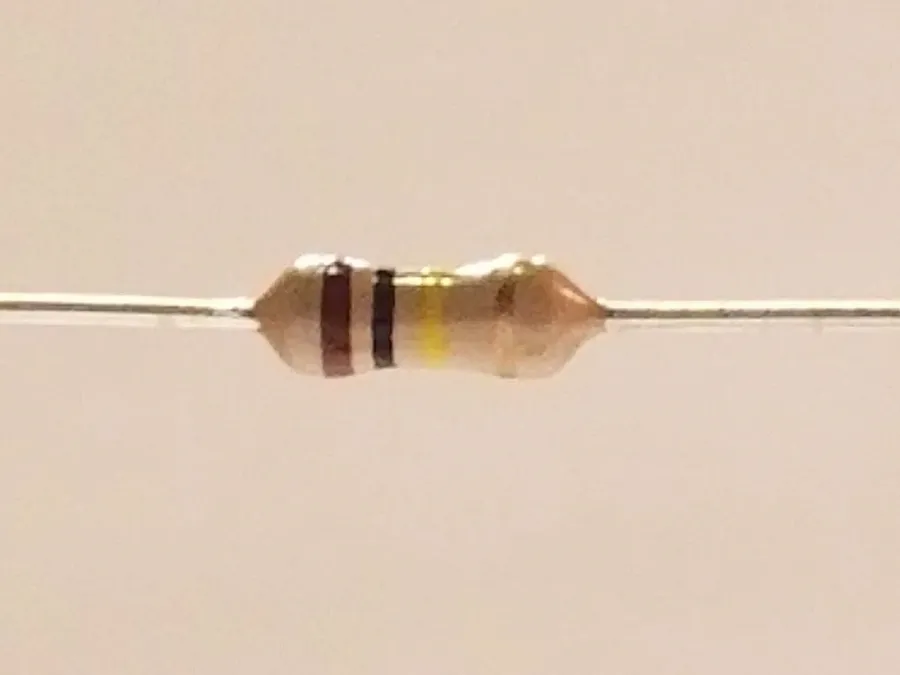
When selecting and sourcing 100k ohm resistors, consider various factors such as package type, quantity needed, and cost-effectiveness. The availability of 100k ohm resistors is widespread due to their common use in many electronic applications. This section provides practical advice on where to purchase these components, comparing different options to help you make informed decisions for your projects.
Sourcing Options:
- Online Retailers
Major online electronics distributors such as Digi-Key, Mouser Electronics, and Arrow Electronics are reliable sources for purchasing 100k ohm resistors. These platforms typically offer a wide selection of resistors from various manufacturers, different package types, and detailed specifications. They provide options for both small and bulk purchases. - Local Electronics Stores
Physical electronics stores, if available in your area, offer the benefit of immediate purchase. These stores often carry a range of common resistor values, including 100k ohm. However, their stock and variety may be limited compared to online retailers. The advantage of purchasing from a local store is being able to examine the products directly before purchase. - Amazon and eBay
These platforms offer options from smaller vendors, often at competitive prices. It's advisable to verify the seller’s reputation, product quality and authenticity before purchase. They can be a good option for smaller quantities or test runs of a design.
Key Considerations When Selecting a 100k Ohm Resistor:
- Package Type
100k ohm resistors are available in axial (leaded) and surface mount (SMD) packages. Axial resistors are through-hole components, ideal for breadboarding and prototyping. SMD resistors are designed for surface mounting on PCBs and are suitable for mass production. Choosing the package type depends on the project and manufacturing requirements. - Quantity
Bulk purchases can significantly reduce the cost per unit if you are planning larger projects or have long-term requirements. However, if you're just experimenting with a new design or need a small quantity, it is better to buy as needed to avoid excess inventory. - Cost
Compare prices across different suppliers, considering the trade-off between cost, quality, and delivery times. While cheaper options may be tempting, ensure the resistors meet your specifications and are from reputable manufacturers. - Lead type
For axial leaded resistors, the lead diameter and plating may need to be considered to work correctly with specific connection methods. If you use surface mount components (SMD), you must specify the correct size according to the board layout. It can be critical for automated assembly processes.
| Factor | Considerations |
|---|---|
| Online Retailers | Wide variety, bulk options, detailed specifications, typically require some lead time to receive delivery. |
| Local Electronics Stores | Immediate availability, convenient for small quantities, potentially limited stock. |
| Package Type | Axial (through-hole) for prototyping, SMD for mass production and compact designs. |
| Quantity | Bulk for large projects, small quantities for prototyping. |
| Cost | Balance between cost, quality, and lead time when ordering. |
Troubleshooting with a 100k Ohm Resistor
Troubleshooting a 100k ohm resistor typically involves identifying issues related to incorrect color coding, physical damage, or operational failures due to excessive electrical stress. Addressing these problems ensures the reliable performance of circuits that rely on this crucial passive component. Proper diagnosis and proactive measures are key to maintaining the integrity of electronic designs.
- Incorrect Color Coding
Misreading or faded color bands can lead to misidentification of the resistor's value. Always double-check the color code using a reliable chart, and when in doubt, use a multimeter to verify the resistance. A 100k ohm resistor should typically have brown, black, yellow, and gold (for a 5% tolerance) bands in a 4-band resistor. Any deviation from this should be checked. - Resistor Failure Due to Overheating
Excessive current passing through the resistor beyond its power rating can cause it to overheat, leading to changes in resistance or complete failure. Signs include discoloration, scorching, or a burnt smell. Ensure the resistor's power rating is adequate for the application and check for proper heat dissipation methods if necessary. - Resistor Failure Due to Over-Voltage
Applying voltage beyond the resistor’s rated tolerance can cause damage. This failure mode is less obvious than overheating but can result in a significant shift in resistance or open circuits. Carefully calculate and verify the maximum voltage drop expected across the resistor, and ensure it stays within the rated limit. - Physical Damage
Physical damage, such as cracks, breaks, or corrosion of the leads, can alter a resistor's electrical characteristics. Handle resistors carefully during installation and regularly inspect them for any signs of physical degradation. - Diagnosing with a Multimeter
A multimeter is essential for troubleshooting resistors. Set the multimeter to measure resistance (Ohms). Connect the probes to both leads of the resistor, and the multimeter should display a value close to 100k ohms if the resistor is functioning correctly. A reading of zero or infinity indicates a short circuit or open circuit respectively. - Best Practices
To ensure the long term functionality of a resistor, use a correct power rating, do not exceed the maximum voltage drop, protect resistors from physical damage, and always double check the color codes with a reliable chart, or measure with a multimeter when in doubt.
Frequently Asked Questions About 100k Ohm Resistors
This section addresses common questions concerning 100k ohm resistors, offering concise and authoritative answers to help clarify any confusion. Understanding the nuances of resistor usage, color coding, and practical applications is crucial for anyone working with electronic circuits.
- What color bands correspond to a 100k ohm resistor?
For a 4-band resistor, the color bands are typically Brown, Black, Yellow, and Gold. Brown represents 1, Black represents 0, Yellow represents a multiplier of 10,000 (10^4) and gold represents a 5% tolerance. For a 5-band resistor, the bands would be Brown, Black, Black, Orange, and Brown, or sometimes Brown, Black, Black, Yellow, and Brown depending on the style of resistor being used. - What is a 100k ohm resistor typically used for?
100k ohm resistors are commonly used in applications that require a moderately high resistance. This includes use in pull-up or pull-down configurations in digital circuits, setting gain in amplifiers, voltage dividers, and in various sensing circuits. It's also a common choice for timing circuits or filtering, providing a balance between current limitation and voltage reduction. - Is a 1k ohm resistor equivalent to 1000 ohms?
Yes, a 1k ohm resistor is indeed equivalent to 1000 ohms. The 'k' stands for kilo, which is a metric prefix meaning 1000, in this case 10^3. Therefore, a 1k ohm resistor is one thousand times the resistance of a 1 ohm resistor. - How does a 100k ohm resistor differ from a 100 ohm resistor?
A 100k ohm resistor offers significantly higher resistance to current flow compared to a 100 ohm resistor, which is 1000 times smaller. This difference is critical because it dramatically alters the behavior of circuits. The 100k ohm resistor will limit current flow substantially more and will dissipate less power than the 100 ohm resistor when placed in the same circuit, making them suitable for different applications. The lower value resistor may be selected for power dissipation or situations when greater current flow is needed. - Why might it be difficult to read a resistor's color code?
Several factors can make it difficult to read a resistor's color code. Faded or smudged bands due to age or handling can obscure the true color. Poor lighting, or color blindness can also affect accurate identification, especially between colors like brown and red. Additionally, some manufacturers may use slightly different color hues, making standard comparisons challenging. Use of a multimeter to verify the resistance when visual inspection is difficult is always recommended. - How do I select the correct wattage for a 100k ohm resistor?
The wattage rating of a resistor indicates how much power it can safely dissipate without overheating. To select the correct wattage, calculate the power the resistor will dissipate using the formula P = I²R or P = V²/R where P is the power, I is the current, R is the resistance, and V is the voltage across the resistor. A safety factor should be applied to ensure reliable operation. If a resistor is expected to dissipate 0.1 watts it is common to choose a 1/4 watt or higher resistor. Operating a resistor near or at its rated power will degrade it. - What does the tolerance rating of a 100k ohm resistor mean?
The tolerance rating indicates the acceptable variance in a resistor's actual resistance from its stated value. A 5% tolerance 100k ohm resistor, for example, can have a resistance value between 95k and 105k ohms. Tolerance is crucial in precision circuits where the exact resistance is vital to circuit performance. Resistors with lower tolerance values are available, but they come with a higher cost.
100k Ohm Resistor vs Other Resistor Values
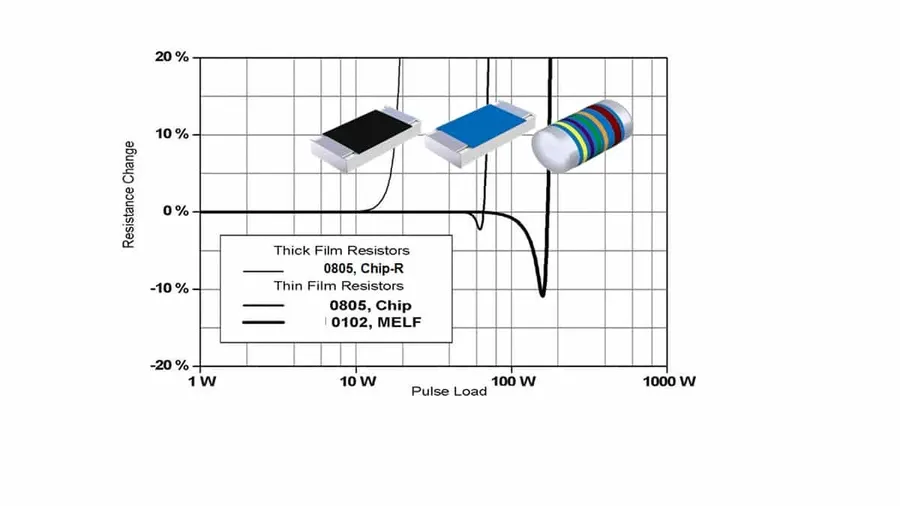
Understanding how different resistor values impact circuit behavior is crucial for effective electronic design. This section contrasts the 100k ohm resistor with commonly used values like 10k ohm and 1M ohm resistors, highlighting their distinct applications and effects.
| Characteristic | 10k Ohm Resistor | 100k Ohm Resistor | 1M Ohm Resistor |
|---|---|---|---|
| Resistance Value | 10,000 Ohms | 100,000 Ohms | 1,000,000 Ohms |
| Typical Current Limitation | Higher current flow compared to 100k and 1M Ohm. | Moderate current limitation, suitable for many applications. | Very low current flow, used where minimal current is desired. |
| Common Applications | Current limiting in LEDs, basic voltage dividers, feedback resistors. | Pull-up/pull-down resistors in digital circuits, feedback in op-amps, high impedance sensing circuits. | High impedance input of amplifier circuits, timing circuits, sensitive signal measurement. |
| Effect on Voltage | Results in lower voltage drops and higher current in a voltage divider when compared to 100k and 1M Ohm. | Provides moderate voltage drops and current in voltage divider circuits. | Results in high voltage drops and very low current in voltage divider circuits. |
| Noise Susceptibility | Less susceptible to noise | Moderately susceptible to noise | More susceptible to noise due to high resistance |
The 100k ohm resistor is a fundamental component that often goes unnoticed yet is crucial in a wide range of electronic circuits. Understanding its function, color code, and applications is essential for anyone involved in electronics, from students to seasoned engineers. From the simple LED circuit to complex digital signal processing the 100k ohm resistor is a versatile workhorse, much like the brain's ability to process diverse information. By mastering the basics of this resistor, you've not only gained practical knowledge but also unlocked the door to more advanced concepts in electronics. Whether you’re building a complex project or simply fixing a broken device, the humble 100k ohm resistor will undoubtedly be a crucial part of your endeavor.
 AnyPCBA
AnyPCBA